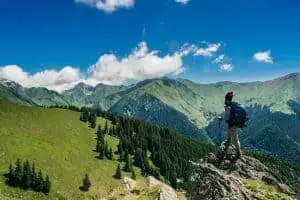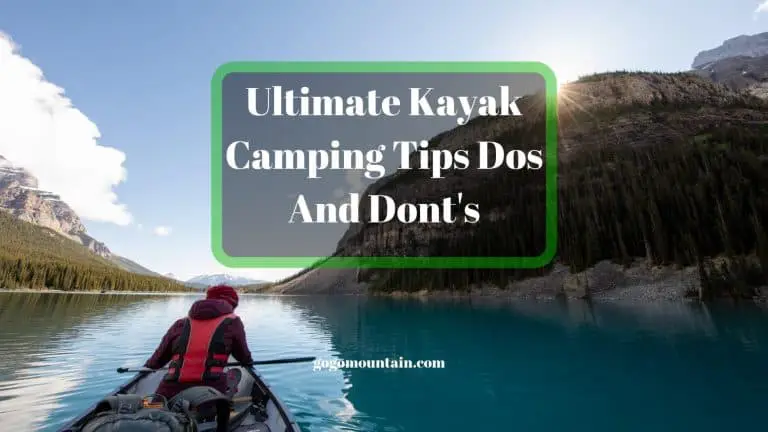16+ Hiking in the Summer Tips and What to Wear to Stay Cool
We will cover hiking in the summer tips & what to wear to stay cool to help you maximize your time in the great outdoors. It will cover what you should wear to stay cool on a summer hike, for guys and ladies, even when you’re hiking in 100-degree heat.
As well, tips to help you enjoy your summertime hike on the trail, like how to see more wildlife.
There is nothing quite like hiking during the summer. While spring, fall, and even winter, offer benefits of their own, being out on the trails during the longest, warmest days of the year will give you a mini-vacation in nature.
 [toc]
[toc]
What to Wear when Hiking in Summer
Let’s start off with unisex summer hiking outfits tips before going into outfit recommendations for guys and ladies.
Skin Care for Summer Hikes
Remember to bring sunscreen that is at least SPF 50 with a summer hike. Some things to look for are reef-friendly and cruelty-free.
If you have oily skin, apply a lightweight moisturizer to control oil on a hot hike. Using a mattifying gel will also refine the complexion and while discouraging future blemishes.
Rain Gear for Summer Hikes
You probably already know that you should pack your rain gear on a summer hiking trip, but are you wearing it correctly?
When you get dressed on a rainy day, open up the pockets and pit zips so that you don’t overheat.
Trapping heat inside your raingear will just make you feel hot, clammy, and sweaty.
You can keep the hood of your jacket out of your eyes by wearing it over a hat with a bill, and you can wear gaiters beneath your rain pants so that rainwater doesn’t make its way into the cuff of your boot.
Summer hiking socks
You know how footwear is important, but there’s another layer between your foot and the right hiking boots.
You’ll want to get lightweight socks when hiking in the summer. Hiking socks are often made of synthetics or merino wool blend because they wick away moisture. They also have ventilation mesh.
Having breathable socks on will control odors and keep your feet comfortable.
Even if your socks will protect you from the risk of blisters and aches, you should pack moleskin patches in case you feel a blister forming.
If you feel a blister start to form and don’t have foot care patches, in a pinch, you can use lip balm, Bodyglide, petroleum jelly, or duct tape.
For a long hike, you could pack athletic tape to be prepared for supporting your joints or alleviating pain. You can use it to wrap around painful joints or backpack chafing with the tape.
Clothes that Protect You from the Sun
Sunburns aren’t just painful when you’re trying to enjoy a nice long hike, they can also make you feel heat sick.
Wear long sleeved shirts with SPF that will block the sun.
Tip: Choose light colors for your outer layers, like your jacket, that will reflect more sunlight. The darker the color of the fabric, the more heat it will absorb from the sun.
To prevent sunburn, select a sunscreen with SPF (30+) that also contains physical blockers like titanium dioxide, and zinc oxide. These chemicals block UV-B and UV-A rays. You should reapply at least once every two hours, as well as faster swimming or sweating profusely.
You should also wear a wide-brimmed hat that is quick to fold up and small enough to store in a one-shoulder backpack.
What to Wear When Hiking in Summer for Guys
Here’s our summer hiking outfit recommendations for guys to keep you cool and prepared for a long or short hike.
Wear Convertible Pants
These hiking long pants can zip off and convert into shorts. The fit is classic cargo, a comfortable loose it, to keep you cool during a summer hike.
It’s also weather-resistant and water repellent to protect from the changing weather. You’ll be prepared for any surprise rain.
Finally, it has plenty of pockets. For a short hike, you might not even need to bring a backpack.
If you prefer to wear shorts on a hot day, you can hang a shirt from the front and back of your backpack to shield your legs from the sun.
3 Ways to Avoid Crowded Hiking Trails in the Summer
Popular hiking trails can get pretty crowded. You can minimize your time stuck in a crowd in the sweltering hot summer with these 3 tips.
1. Start at the crack of dawn.
Don’t wait for the sun to rise for you to start your trip. If you are ready to go and hit the trailhead by sunrise, you’ll increase your likelihood of beating the crowds and get a better viewing of local wildlife.
You can also get most of your hiking in during the cooler hours in the morning after the late afternoon.
You can save the hot periods in the middle of the day for naps or meals under a portable popup tent.
2. Go further away from the main trail.
Instead of hiking on the main popular trail, start your hike from a further-out trailhead.
Most hikers will stop hiking to set up camp or sight-seeing within just the first few miles.
The further away you go, the less likely you are to encounter crowds.
3. Try nighttime hiking.
If you’re not familiar with the trail, grab a friend and a flashlight. As well, stay on the main well-travelled trail.
This tip may not be for the faint of heart. However, it’s worth a try if you’ve never done it.
You can see the wilderness in a whole new way, allowing you to experience the sights, sounds, and adventures you’ve never dreamed of.
Plus, most trails are empty after the sun goes down, so you probably won’t see anyone while you’re out there.
Night time Hiking in the Summer Tips
Select trails that are wide and clear
Easy trails are best at night when devoid of any tree roots or low-hanging branches. These can be hazardous in the dark. Ask local rangers for recommendations.
Time your hike so that it matches up with a full moon for best visibility
There are some parks, like Bryce Canyon, that will offer free, fully-guided moonlit hikes.
Wait to turn on your headlampYou should wait until your eyes have adjusted to the dark. This should take about thirty minutes.
To protect your night vision, use the red light on your headlamp
Use the red light when reading a map or trail sign because the default white light will get rid of your night vision.
Prep your gear ahead of time
Organizing your gear into clear, labeled totes will make it easier for you to find things quickly.
You won’t have to scramble as you’re headed out the door for your hike, and can instead beat the crowds by arriving at the trailhead early.
If you don’t plan on staying the night, you can use a lightweight, one-shoulder backpack for your hiking necessities.
Stock up on backpacking food and staples
Save yourself a trip to the store on a busy Friday afternoon by having all of your food stocked and ready to go.
Most camping food doesn’t require refrigeration anyway, so there’s no reason not to buy in bulk.
Don’t procrastinate on washing and prepping your gear
When you return from a camping or hiking trip, try to clean your gear immediately.
Wet gear can grow mold. Not only will the task be easiest as soon as you’ve arrived back from your trip, but you’ll also have everything ready to go for your next adventure.
5 Best Hiking in the Summer Tips

1. How to See Wildlife on Your Summer Hike
Moose
Keep a close eye out for moose in the summertime. They are at the peak of their growth during this time of the year, and they are absolute behemoths.
Weighing over 1,200 pounds and standing at well over six feet tall, these mammals tend to be found in or near willow ponds, marshes, and rivers.
You can approach them if you are downwind, but make sure you keep your distance.
Don’t get any closer than 50 yards away, as moose are known to charge humans who appear to be threatening.
A great hiking trail to view moose? The String Lake Trail in Grand Teton National Park.
Bald eagles
Bald eagles can be found throughout North American at any time throughout the year, but are most easily spotted in May and June.
That’s when parent eagles will hang out near their aeries while they care for their young.
You can spot their large, five-foot-wide stick nests in the treetops and cliffs near bodies of water.
A great hiking trail to view bald eagles? Head out for a paddle on any one of the lakes in Voyageurs National Park.
Bighorn sheep
These majestic creatures can be found on the rocky, steep inclines of the mountains and high deserts of the Southwest, particularly in the Rockies.
Watch for their white bottoms among the rocks. You can view ewes with their lambs in the spring, usually from April to June.
In the fall, you might catch rams butting heads with each other during the rut.
A great hiking trail to view bighorn sheep? The Highline Trail of Glacier National Park.
2. How to Protect Your Knees on Long Hikes
Hiking is hard on your body in general, and particularly on your knees.
The thing to avoid unnecessary stress is to cut down on the weight in your backpack. Every pound of weight that you carry on your back puts an additional seven pounds of pressure on your knee joints when you’re climbing uphill.
A lighter pack can do the trick to cure your achy knees, as can hiking poles that help to reduce the impact on your knees when you’re walking downhill.
If you still find that your knees are bothering you, you may want to take ibuprofen and ice your knees when you arrive at a resting spot. Taking smaller steps can help to lighten the load, too.
3. Hiking in the Summer and Mosquitoes
Nobody wants to deal with bugs while they’re enjoying the wilderness, and there are plenty of bugs while hiking in the summer months.
DEET is an effective spray to repel mosquitoes and some other bugs that you will want to bring with you for touch-ups.
If you want to reduce your exposure to DEET, spray a cotton bandana and tie it around your neck. Be sure to do it only on cotton because DEET tends to melt synthetic fabrics.
There are also alternative bug sprays formulated without DEET.
4. Hike Further on Steep Inclines
You can conserve your energy while hiking on steep inclines by using the rest step technique.
To do this, lock your back knee with each stride, resting your weight on that leg for a breath.
Then, step up and allow momentum to swing your back leg forward.
Engage pressure breathing by exhaling forcefully through lips that are pressed together.
This will allow more air to enter when you inhale.
5. Consider a packing list
Finally, even veteran wilderness experts forget things from time to time.
Prevent this by printing a packing list ahead of time, and cross of each item as you load or pack it.
You can also get a book of packing lists for hiking, camping, and more.
Hope you enjoyed our best hiking in the summer tips!
Related Posts:
Best Men’s Backpacking Boots
Top 5 Best Women’s Hiking Shoes
40+ TIPS Day Hiking for Beginners – How to Start Hiking











